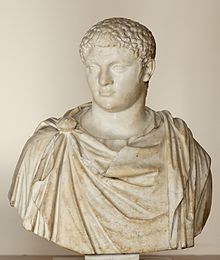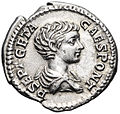Geta (emperor)
This article needs additional citations for verification. (December 2010) |
| Geta | |||||
|---|---|---|---|---|---|
 | |||||
| Joint 22nd Emperor of the Roman Empire | |||||
| Reign | 209 – December 211 | ||||
| Predecessor | Septimius Severus | ||||
| Successor | Caracalla | ||||
| Co-emperors | Severus (209–Feb.211) Caracalla (209–Dec.211) | ||||
| Born | 7 March 189 Rome | ||||
| Died | 26 December 211 (aged 22) | ||||
| |||||
| Dynasty | Severan | ||||
| Father | Septimius Severus | ||||
| Mother | Julia Domna | ||||
| Roman imperial dynasties | ||
|---|---|---|
| Severan dynasty - tondo.png | ||
| Severan dynasty | ||
| Chronology | ||
|
193–211 |
||
|
with Caracalla 198–211 |
||
|
with Geta 209–211 |
||
|
211–217 |
||
|
211 |
||
|
Macrinus' usurpation 217–218 |
||
|
with Diadumenian 218 |
||
|
218–222 |
||
|
222–235 |
||
| Dynasty | ||
| Severan dynasty family tree | ||
|
All biographies |
||
| Succession | ||
|
||
Geta (Publius, or Lucius, Septimius Geta Augustus;[note 1] 7 March 189 -26 December 211),[1] was a Roman emperor who ruled with his father Septimius Severus and his older brother Caracalla from 209, when he was named Augustus like his brother who had held the title since 198. Severus died in 211, and although he intended for his sons to rule together, they proved incapable of sharing power culminating with the murder of Geta in December of that year.[2]
Early life
Geta was the younger son of Septimius Severus by his second wife Julia Domna. Geta was born in Rome, at a time when his father was only a provincial governor at the service of Emperor Commodus.
Conflicts between Geta and Caracalla were constant and often required the mediation of their mother. To appease his younger son, Septimius Severus gave Geta the title of Augustus in 209.
During the campaign against the Britons in the early 3rd century CE, imperial propaganda promoted the image of a happy family that shared the responsibilities of rule. Septimius Severus entrusted Julia Domna with the role of counsellor, Caracalla acted as the emperor's second in command, and administrative and bureaucratic duties were Geta's responsibility. In reality, however, the rivalry and antipathy between the brothers did not abate.
Joint Emperor
When Septimius Severus died in Eboracum in early 211, Caracalla and Geta were proclaimed joint emperors and returned to Rome.
Their joint rule was a failure. Later sources speculated that the brothers wished to split the empire in two halves. By the end of 211, the situation had become unbearable. Caracalla tried unsuccessfully to murder Geta during the festival of Saturnalia. Finally, on the 19th of December, Caracalla had his mother arrange a peace meeting with his brother in his mother's apartments, and then had him murdered in her arms by centurions.
Following Geta's assassination, Caracalla ordered his brother's name to be removed from all inscriptions. The now sole emperor also took the opportunity to get rid of his political enemies, on grounds of conspiracy. Cassius Dio stated that around 20,000 men and women were killed or proscribed during this time.[3]
Portrait
Very few marble portraits attributable to Geta survive to date, presumably due to the very thorough damnatio memoriae which resulted in the erasing of his images. However Roman coins with his image are plentiful, and can reflect how his father Septimius Severus and later Geta himself wanted him to be seen by the Roman people (and especially the Roman military).
Images of Geta and his older brother Caracalla cannot be well distinguished until the death of the father. Both sons were supposed to be presented as equally suitable heirs to the throne, showing thus more "depth" to the dynasty.
On his coins Caracalla, who became Augustus in 197, was shown with a wreath of laurels, while Geta remained bareheaded until he himself became Augustus in 209.[4] Between 209 and their father's death in February 211, both brothers were shown as equally mature young men with a short full beard, ready to take over the empire. Between the death of Septimus Severus and the assassination of Geta, Caracalla's portraits did not change, while Geta was depicted with a long beard with hanging hairs much like his father, a strong indication of Geta's efforts to be seen as the "true" successor of his father.[4]
Gallery
-
Head of young Geta at Glyptothek, Munich.
-
A denarius of Geta.
-
The Severan Tondo, a painting of Septimius Severus with Julia Domna, Caracalla, and Geta, whose face is smeared out, probably because of the damnatio memoriae put against him by Caracalla.
| |||||||||||||||||||||||||||||||||||||||||||||||||||||||||||||||||||||||||||||||||||||||||||||||||||||||||||||||||||||||||||||||||||||||||||||||||||||||||||||||||||||||||||||||||||||||||||||||||||||||||||||||||||||||||||||||||||||||||||||||||||||||||||||||||||||||||||||||||||||||||||||||||||||||||||||||||||||||||||||||||||||||||||||||||||||||||||||||||||||||||||||||||||||||||||||||||||||||||||||||||||||||||||||||||||||||||||||||||||||||||||||||||||||||||||||||||||||||||||||||||||||||||||||||||||||||||||||||||||||||||||||||||||||||||||||||||||||||||||||||||||||||||||||||||||||||||||||||||||||||||||||||||||||||||||||||||||||||||||||||||||||||||||||||||||||||||||||||||||||||||||||||||||||||||||||||||||||||||||||||||||||||||||||||||||||||||||||||||||||||||||||||||||||||||||||||||||||||||||||||||||||||||||||||||||||||||||||||||||||||||||||||||||||||||||||||||||||||||||||||||||||||||||||||||||||||||||||||||||||||||||||||||||||||||||||||||||||||||||
Notes:
Bibliography:
| |||||||||||||||||||||||||||||||||||||||||||||||||||||||||||||||||||||||||||||||||||||||||||||||||||||||||||||||||||||||||||||||||||||||||||||||||||||||||||||||||||||||||||||||||||||||||||||||||||||||||||||||||||||||||||||||||||||||||||||||||||||||||||||||||||||||||||||||||||||||||||||||||||||||||||||||||||||||||||||||||||||||||||||||||||||||||||||||||||||||||||||||||||||||||||||||||||||||||||||||||||||||||||||||||||||||||||||||||||||||||||||||||||||||||||||||||||||||||||||||||||||||||||||||||||||||||||||||||||||||||||||||||||||||||||||||||||||||||||||||||||||||||||||||||||||||||||||||||||||||||||||||||||||||||||||||||||||||||||||||||||||||||||||||||||||||||||||||||||||||||||||||||||||||||||||||||||||||||||||||||||||||||||||||||||||||||||||||||||||||||||||||||||||||||||||||||||||||||||||||||||||||||||||||||||||||||||||||||||||||||||||||||||||||||||||||||||||||||||||||||||||||||||||||||||||||||||||||||||||||||||||||||||||||||||||||||||||||||||
See also
Notes
- ^ In Classical Latin, Geta's name would be inscribed as PVBLIVS SEPTIMIVS GETA AVGVSTVS.
References
- ^ Birley 1999, p. 324.
- ^ Varner, Eric R. Mutilation and Transformation: Damnatio Memoriae and Roman Imperial Portraiture (2004) Brill Academic Publishers. p. 168
- ^ Cassius Dio, Roman History [1]
- ^ a b Template:De icon Andreas Pangerl: Porträttypen des Caracalla und des Geta auf Römischen Reichsprägungen - Definition eines neuen Caesartyps des Caracalla und eines neuen Augustustyps des Geta; Archäologisches Korrespondenzblatt des RGZM Mainz 43, 2013, 1, 99–116
Bibliography
- Dio Cassius lxxvii; Herodian iv. I.
- Birley, Anthony R. (1999) [1971]. Septimius Severus: The African Emperor. London: Routledge. ISBN 0415165911.
{{cite book}}: CS1 maint: ref duplicates default (link)
External links
- Life of Geta (Historia Augusta at LacusCurtius: Latin text and English translation)
- 189 births
- 211 deaths
- Carthaginians
- Characters in works by Geoffrey of Monmouth
- 3rd-century Roman emperors
- Imperial Roman consuls
- Severan dynasty
- Septimii
- People from Rome
- British traditional history
- Murdered Roman emperors
- Deified Roman emperors
- Roman emperors to suffer posthumous denigration or damnatio memoriae
- People from Homs
- Royal Family of Emesa
- Burials at the Castel Sant'Angelo



